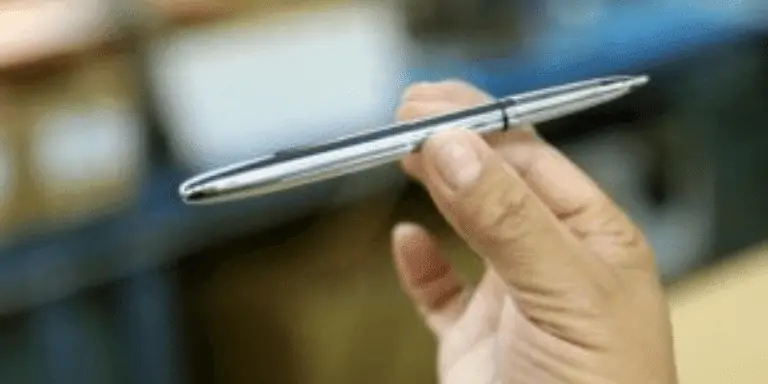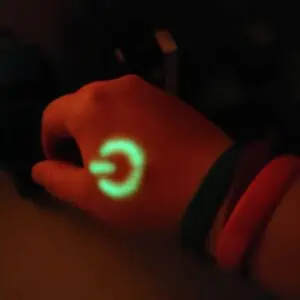The space pens have been used on every crewed NASA mission since Apollo 7 – dozens are currently aboard the International Space Station.
Table of Contents
ToggleThe Space Pen is a pen that uses pressurized ink cartridges and is able to write in zero gravity, underwater, over wet and greasy paper, at any angle, and in a very wide range of temperatures. Therefore Space Pen is also known as the Zero Gravity pen and is marketed by Fisher Space Pen Company.

The “Space Pen” was invented by Austrian, Friedrich Schächter and expanded by Erwin Rath. Paul C. Fisher, invented the “thixotropic special ink”. Paul C. Fisher first patented the AG7 “anti-gravity” pen in 1965.
Currently, son of Paul C. Fisher, Cary Fisher, Paul’s son is the president of the Fisher Space Pen company, which is now located in Boulder City, Nevada. The pens are on display in space museums and in the permanent collection of the Museum of Modern Art in New York.
Fisher Space Pens
The Fisher Space Pen is a special type of ballpoint pen, containing thixotropic ink and a pressurized ink cartridge. This pen is able to write on almost any substance, ranging from butter to steel as well as it can survive a wide range of temperatures, ranging from -50 to 160 degrees Fahrenheit.
The pens can also work in all positions, in extreme heat and cold, and in atmospheres ranging from pure oxygen to vacuum. And the pen contains enough ink to draw a solid line more than three miles long – well beyond NASA’s half-kilometer (.3-mile) ink requirement.
The AG7 model was the very first Fisher Space Pen. (Image Credits: Fisher Pen Company)
After vigorous testing at NASA’s Manned Spacecraft Center (now Johnson Space Center in Houston), NASA approved Fisher’s Space Pen to be used in space and purchased three different models; the 204, 207, and 208. The model 204 had blue ink and a retraction button on the end.
First NASA used this on Skylab (the first United States space station, launched by NASA) and the Apollo missions (the third United States human spaceflight program carried out by NASA, the first humans on the Moon from 1968 to 1972).
The model 204 pen was later replaced by model 207. The 207 model was similar to model 204 with modification of the retraction button, which had been moved to the side.
The model 208 pen was the same as the 207 but had black ink. Currently, the Space Pen line now comprises about 80 models.
The myth about the cost of Space pens
It’s also the subject of a myth that the space agency spent millions to invent a pen that can write in zero gravity, while cosmonauts simply used a pencil.
Recently in a post of NASA stated that NASA didn’t cost taxpayers millions. Paul Fisher at the Fisher Pen Company had already been working on a pressurized pen.
That said, it likely would never have reached the heights it did, in orbit or in popularity, without NASA’s testing.
According to him, “The early original ballpoints were terrible, ballpoints tended to leak, skip, and dry up.
To solve these problems, his father Paul C. Fisher, who had already invented the first universal ink cartridge refill, was working on a sealed cartridge with pressurized nitrogen at the top pushing a tiny piston against the ink. But the pressure caused the pens to leak. ”
When NASA reached out to him looking for a pen that didn’t require gravity and can work in space, he knew this pressurized ink cartridge could be just the thing – if he could solve the leaks.
With NASA’s interest spurring him on, he finally succeeded when he added resin to the ink to make it “thixotropic” – almost solid until friction with the ball at the point of the pen liquefied it. He called the result the AG7, for anti-gravity, and sent several to NASA.
Thereafter, NASA’s extensive testing, the pen was approved for use in space, and that testing accelerated the pen’s development from a prototype to a safe, reliable product.
Once it had flown in space, Paul decided on the name Space Pen. “I thought it was a terrible name,” his son recalled. “I said it’s going to sound like a toy. But my father was right, as he often was.”
Paul and his son continued perfecting the technology and designing new models.
Why not just use a pencil?
The pencil wasn’t an ideal choice for writing in space because its lead could easily flake, break off and float away, drifting in microgravity with the potential to create a hazard to astronauts and sensitive electronics on the spacecraft.
Apart from this, pencils are flammable, and NASA wanted to avoid anything flammable aboard a spacecraft. Cosmonauts (astronauts of the Soviet or Russian space program) also have been using Space Pens since 1969.
Do astronauts still use Space Pens?
The space pens have been used on every crewed NASA mission since Apollo 7 – dozens are currently aboard the International Space Station. Over the years, Fisher’s company has created different space pens, which are still used by NASA and the Soviet space agency.
Is it only for space?
There are about 80 models of Space Pens and are especially in demand among members of the military and law enforcement, as well as outdoor plane manufacturers, enthusiasts, and oil workers, all of whom, like astronauts, appreciate their ability to write in any conditions.
Fisher Pen Company makes all its pens in Boulder City, Nevada with more than 60 employees and turn out over a million space pens in a year. The company has distributors in 52 countries.
You May Also Read:
















